SEDE VACANTE 1774-1775
(September 22, 1774—February 15, 1775)
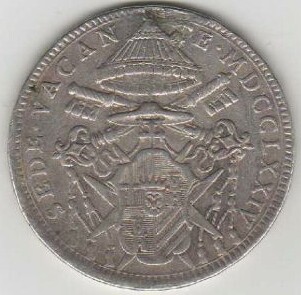 |
AG 1/2 scudo SEDE • VACAN | TE • MDCCLXXIV Shield with the Coat of Arms of Carlo Cardinal Rezzonico, Camerlengo of the Holy Roman Church (1763-1799), crossed keys above, surmounted by Cardinal's hat with six tassels on each side; the Ombrellone over all. |
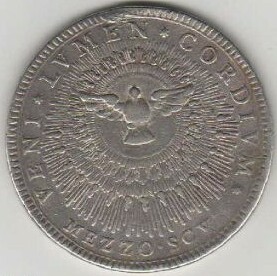 |
VENI • LVMEN • CORDIVM • MEZZO • SCV: The Holy Spirit, surrounded by rays and tongues of fire (Pentecost). Berman, p. 190 #2946. |
CARLO CARDINAL DELLA TORRE REZZONICO, iuniore (1724-1799), nephew of Pope Clement XIII (1758-1769), who ordained him as a priest. He was made Referendary of the Tribune of the Apostolic Segnatura in 1751. After his uncle became pope, he was immediately named Cardinal Deacon (September 11, 1758) and Vice-Chancellor of the Holy Roman Church (1758-1763). He was named Chamberlain of the Holy Roman Church on January 24, 1763, a post which he held until his death on January 26, 1799. He was fifty-five at the time of the conclave of 1774-1775, ad was the leader (according to Cardinal de Bernis) of the largest faction. In the new reign (Clement XIV) in 1773 he became Cardinal Bishop of Sabina, exchanging it for Porto and Santa Rufina in 1776. He was Archpriest of the Lateran and Secretary of the Roman Inquisition.
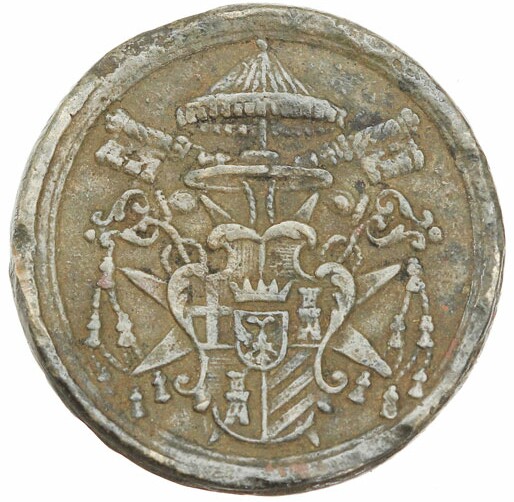 |
Æ 28mm Shield with the Coat of Arms of Carlo Cardinal Rezzonico, Camerlengo of the Holy Roman Church (1763-1799), star of the Knights of Malta behind, crossed keys above, surmounted by Cardinal's hat with six tassels on each side; the Ombrellone over all. |
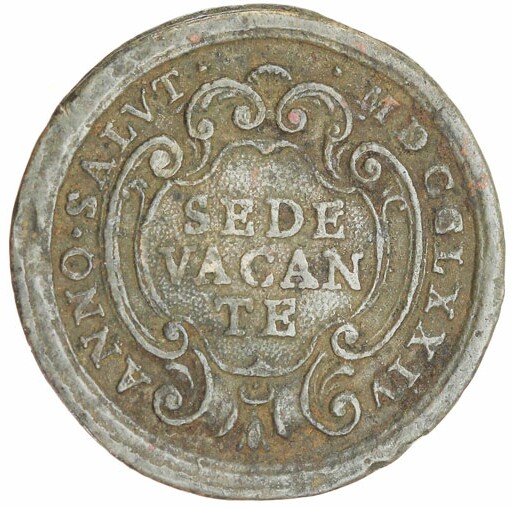 |
On shield: |
MSGR. GUGLIELMO PALLOTTA (1727-1795) was born in Macerata, a relative of cardinals of the 16th and 17th century. He studied law in Rome and became a protege of Carlo Card. Rezzonico. He was made a canon of the Vatican Basilica, and served on the board of the Rev. Fabbrica. He was Secretary of the Sacred Congregation of Good Government, and was appointed Treasurer General of the Apostolic Chamber (Reverendae Camerae Apostolicae Thesaurius Generalis) in 1773. He was created Cardinal Priest of S. Eusebio on June 23, 1777, and transferred to Santa Maria degli Angeli (S. Maria in Thermis Diocletianis) in 1782. He was Prefect of the Sacred Congregation of the Council of Trent from July 1, 1785 to his death on September 21, 1795.
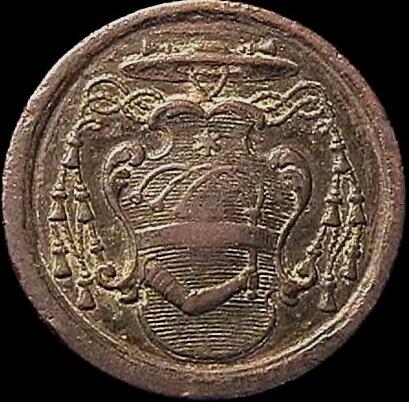 |
Æ 28mm Shield with coat of arms of Msgr. Guglielmo Pallotta, surmounted by clerical hat, with six tassels on each side (signifying episcopal status) |
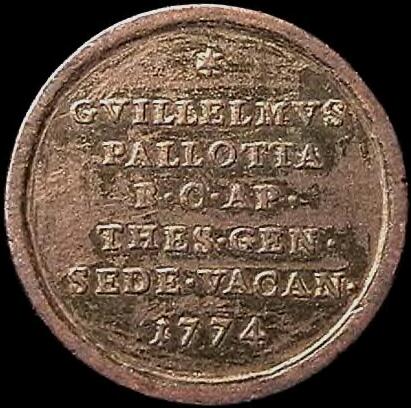 |
|
"L' origine de tant de médailles remonte à l'époque où le conclave se tenait toujours au palais du Vatican, et où l'on interdisait à tout le monde, pendant tout le temps de sa durée, l'entrée de la cité Léonine, c'est-à-dire du quartier appelé le Borgo. Alors tous ceux qui, soit pour leurs affaires, soit pour tout autre motif, devaient se rendre dans ce quartier du Borgo, étaient arretés en tête du pont Saint-Ange ou de tout autre pont communiquant avec le Vatican; on ne laissait passer que ceux qui étaient porteurs d'une médaille expressément frappée pendant la vacance du siége au nom de l'un des personnages nommés ci-dessus." X. Barbier de Montault, Le Conclave (Roma 1878) 19. |
Fabrizio Cardinal Serbelloni was the Dean of the Sacred College of Cardinals and Cardinal Bishop of Ostia.
The Prefect of the Sacred Apostolic Palaces (Majordomo) and Governor of the Conclave was Msgr. Giovanni Archinto (1736-1799), the nephew of Cardinal Alberico Archinto (1756-1766) and of Vitaliano Borromeo (1766-1793). Doctor in utroque iure (Rome, La Sapienza). He was appointed titular Archbishop of Philippi, in order to carry out the office of Nuncio in Tuscany (1766-1769). He was named a cardinal on April 15, 1776.
The Governor of Rome and of the Borgo was Msgr. Giovanni Potenziani.
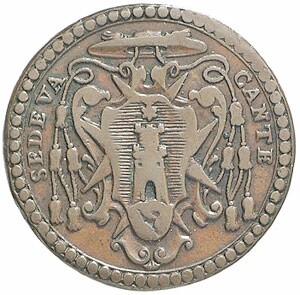 |
Æ 28mm SEDE VA | CANTE Shield with coat of arms of Msgr. Giovanni Potenziani, upon a cross of the Knights of St. John of Jerusalem, surmounted by clerical hat, with six tassels on each side (signifying episcopal status) |
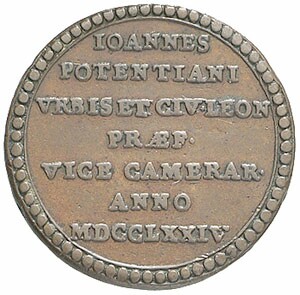 |
|
The Masters of Ceremonies were: Msgr. Giuseppe Dini, Canon of S. Maria in Via Lata, Secretary of the SC Cerimoniale; Msgr. Francesco Gaetano Diversini, Beneficiato di S. Pietro in Vaticano; Msgr. Giovanni Lucca, Privy Chamberlain to His Holiness; Msgr. Giovanni Battista Valeriani, Beneficiato di S. Pietro; Ab. Giovanni Battista Lizzani, Beneficiato di S. Maria Maggiore; and Ab. Marcello Amici, Beneficiato di S. Pietro.
Msgr. Diversini died as Praefectus Caeremoniis on March 31, 1776 at the age of 91; his memorial inscription is in S. Barbara de' Librarii: V. Forcella, Inscrizioni delle chiese di Roma VII, p. 400, no. 822].
Death of Pope Clement XIV (Ganganelli)
Pope Clement XIV had been ill on and off during most of his pontificate (extensively detailed by the French Ambassador in Rome, Cardinal de Bernis, in his dispatches to the French Foreign Ministers, Aiguillon. the Duc de Choiseul, and the Comte de Vergennes). The Pope was under constant extraordinary stress because of the Jesuit issue, deliberately imposed on him by both sides. He was subject to severe depressions, and he imagined that his life was in danger (which was no paranoid delusion), and that he was a target for assassination by poison. Cardinal Bernis noticed a change for the worse in the pope's health in an audience of August 16, which he confirmed on August 24 and 28. On September 7, Clement seemed to be in remission, and even proposed a vacation for himself at Castel Gandolfo. On the 8th he presided at ceremonies at S. Maria del Popolo, celebrating the Birthday of the Blessed Virgin Mary, and seemed fatigued. Nonetheless, he still planned to leave for Castel Gandolfo on Monday the 12th. He did not look at all well, as Msgr. Giorgio D'Adda, Prefect of the Signature of Justice, noted in a letter of September 10 with some alarm:
Il Papa parte Lunedi [Monday, September 12] per la Villeggiatura di Castel Gandolfo, mà si trova molto mal ridotto, e se l'aria della Campagna non lo ristabilisce guaj à noi, mentre nelli tempi presenti sarebbe fatale una Sede vacante.
Clement had contracted a remittant fever. On the evening of the 19th he had a blood-letting, and another the next morning [Cardinal Bernis to the Comte de Vergennes, September 20, 1774]. The Pope's principal physician was Dr. Natale Saliceti, of the Istituto anatomica e chiurgico, and lecturer at the Sapienza; the Pope's private physician was Monsignor Pasquale Adinolfi, supernumerary lecturer in Medicine at the Sapienza. Cardinal Malvazzi, the papal Datary, who lived in the Apostolic Palace, was able to force his way in to see the Pope on September 20, and intimated to His Holiness that it would be appropriate and necessary for him to receive the Viaticum. The ceremony was carried out that evening [Bernis to Vergennes, September 21, 1774]. Afterwards a struggle developed with the Pope over the issue of revealing the names of the eleven cardinals who had been created in the Consistory of April 26, 1773, but who were still reserved by the Pope in petto. Cardinal Malvezzi, the Datary, the Spanish Minister Florida Blanca, and Cardinal de Bernis pressed hard for the names to be announced, and apparently the Pope agreed to do so. Witnesses were needed, and so Cardinals Pallavicini (the Secretary of State), Simone, and Negroni (the Secretary of Briefs) were summoned, but the Pope seemed to have changed his mind (or to have been misunderstood in the first place). Malvezzi and the Pope's confessor, tried to insist, but were rejected. No revelations were forthcoming. [Bernis to Durini, September 21, 1774; Carayon no. CLXXVI, pp. 275-276]. Bernis and his associates, of course, were attempting to increase the number of votes at the disposal of the Bourbon Crowns for the imminent Conclave. An alternative story is concocted by Artaud de Montor, which places the blame on Fr. Bontempi, the Confessor, who sans doute revealed his scruples concerning some of the men who had been named in petto, and persuaded the Pope not to reveal their names while Malvezzi was out of the room, summoning witnesses [Montor VIII, p. 42].
On Wednesday, the 21st, at 7 p.m, Clement received Extreme Unction, in the presence of the Cardinals and the heads of the religious orders [one of whom, Fr. Francesco Saverio Vasquez del Peru, the Prior General of the Order of St. Augustine, recorded the event: Rousseau, p. 406], and the next morning, Thursday, September 22, 1774, at 8:00 a.m. he died. He was 69 years of age.
In a letter of October 8, 1774 [Calvi, p. 372], Msgr. Giorgio D'Adda, Prefect of the Signature of Justice, remarked to his brother:
Da Francia pure erano venuti avvisi al Papa che si guardasse: insomma non si è veduta morte tanto costantemente minacciata come questa, ed una quale nè li balsami, nè la pece, e nepur il gesso ha potuto rimediare, staccandosi la testa dal collo, e le dita dalle mani, e li piedi dalle gambe al solo toccarlo, e tutto ciò in meno di 24 hore. Il Medico Saliceti hon ha voluto dichiararlo veleno, mà ha admesso potersi anche al veleno attribuire quelli segni; li altri Professori però che hanno assistito alla sezione del Cadavere quasi tutti sono stati concordi in giudicarlo veleno, e li Ministri per tale lo hanno caratterizzato nelle loro Relazioni alle Corti.
The examination at the enbalming indicated—in the midst of rumors, asservations and denials—that the Pope had been poisoned. When they tried to remove his ring, the finger came off along with it. The hairs and nails fell off. Rapid decomposition of the corpse made a public viewing of the face and hands impossible. In their report the doctors (who had refused to carry out a formal autopsy) were circumspect enough to call the alarming variety of symptoms "universal gangrene" [Rousseau, p. 409]. Cardinal de Bernis wrote to the French Minister Vergennes that he believed that the Pope had been poisoned, though he later retracted that view. Nonetheless, the Courts of Versailles, Madrid and Naples professed to believe the story—the same courts which had pressed so hard for the suppression of the Jesuits. For the French archivist and apologist for Cardinal Bernis, Frédéric Masson, it all comes down to this: "La preuve que le pape n'a pas été empoisonné en 1774, c'est qu'il ne l'a été ni en 1770, ni en 1771, ni en 1773." (cf. Masson, pp. 286-296) What profound reasoning! What an idiot!
On Saturday night the body of the pope was placed in the Sistine Chapel in the Vatican Palace.
The Cardinals
An official list of all the cardinals who attended the Conclave with their dapiferi is given as an attachment to the Motu Proprio of Pius VI of April 5, 1775, Nos Volentes [Andrea Barberi (editor), Bullarii Romani Continuatio Tomus Quintus (Romae 1842) pp. 42-43; the editors of that work stupidly chose not to print the much more interesting list of Conclavists attached to the Motu Proprio of April 6, 1775 [no XIV. pp. 28-34]. Grants were made to the dapiferi of 5 Cardinal Bishops (Stoppani having died); twenty-eight Cardinal Priests (placing Braschi, who was elected Pope, separately at the top of the list. De' Rossi, who died during the Conclave, is also omitted); and ten Cardinal Deacons.
- Fabrizio Serbelloni (aged 79) [Milan], Bishop of Ostia e Velletri, Dean of the Sacred College of Cardinals (died December 7, 1775). Former Nuncio in Cologne (1734–1738), Poland (1738–1746), and Vienna (1746–1753).
- Giovanni Francesco Albani (aged 54) [Urbino, born in Rome], Bishop of Porto e Santa Rufina, Sub-Dean of the Sacred College of Cardinals (died September 15, 1803)
- Henry Benedict Mary Clement Stuart (aged 49) [Rome], Bishop of Frascati, with S. Lorenzo in Damaso in commendam (died July 13, 1807). Vice-Chancellor S.R.E. "Duke of York" [Bullarii Romani Continuatio Tomus Quintus, continens pontificatus Pii VI annum primum ad tertium (Romae 1842), p. 33].
- Giovanni Francesco Stoppani (aged 79) [Milan], Bishop of Palestrina. (died November 18, 1774, during the Sede Vacante)
- Carlo Rezzonico, iuniore (aged 50), Bishop of Sabina (died January 26, 1799). Pro-Jesuit.
- François-Joachim de Pierres de Bernis (aged 59), Bishop of Albano. Archbishop of Albi (1764-1794) Minister Plenipotentiary of His Most Christian Majesty to His Holiness (died November 3, 1794).
- Carlo Vittorio Amedeo delle Lanze (aged 62), Cardinal Priest of S. Prassede (died January 25, 1784). Prefect of the S.C.of the Tridentine Council.
- Vincenzo Malvezzi (aged 59), Cardinal Priest of Ss. Marcellino e Pietro (died December 3, 1775). Archbishop of Bologna, pro-Datary of His Holiness.
- Antonio Sersale (aged 72) [Sorrento, Kingdom of Naples], Cardinal Priest of S. Pudenziana (died June 24, 1775). Archbishop of Naples.
- Francisco de Solís Folch de Cardona (aged 61) [Madrid], son of José Solís y Gante, Marquis of Castelnovo, Count of Saldueña and Duke of Montellano. Cardinal Priest without titulus Archbishop of Seville (1755-1775). Confidant of King Charles III of Spain and of the Conde de Aranda. "El cardenal de Solís llegó tarde al cónclave, y aunque hizo cuanto pudo en sus fuerzas, la falta de conocimiento del país, del carácter de las personas y de la lengua le ponia estorbos insuperables." (Conde de Florida Blanca, Spanish Minister in Rome, Memorial) Given the titulus of SS. XII Apostoli (1769–1775) after the Conclave, on June 26, by the new Pope Clement XIV. He died on March 21, 1755. Unusually, Pope Pius VI attended his funeral, along with thirty cardinals, with the Requiem Mass being sung by Cardinal Calini. The Pope gave the final absolution. The body was enbalmed and transferred to Seville; he was buried in Seville on April 12, 1775. His heart was buried in SS. XII Apostolorum [Biografia eclesiastica completa 27 , 808-809].
- Paul d'Albert de Luynes (aged 71) [Versailles], son of Honoré, Duc de Monfort; grandson of the Duc and Duchesse de Chevreuse. Cardinal Priest of S. Tommaso in Parione (1758–1788). Archbishop of Sens (1753–1788), on the nomination of King Louis XV. (died January 21, 1788).
- Ferdinando Maria de' Rossi, Cardinal Priest of S. Cecilia (1767–1775). Prefect of the S.C. of the Tridentine Council. (died February 4, 1775 during the Sede Vacante)
- Girolamo Spinola (aged 60), Cardinal Priest of S. Balbina (died July 22, 1784). Legate before future Queen Maria Carolina of Naples.
- Giuseppe Maria Castelli (aged 68), Cardinal Priest of SS. Bonifacio ed Alessio (1759–1780) Prefect of the S.C. de Propaganda Fide (1763–1780). (died April 9, 1780).
- Gaetano Fantuzzi (aged 65) [Ravenna], Cardinal Priest of S. Pietro in Vincoli (died October 1, 1778).
- Marcantonio Colonna (aged 60), Cardinal Priest of S. Maria della Pace (1762–1784). Vicar-General of Rome (1762–1793). Archpriest of S. Maria Maggiore (died December 4, 1793).
- Andrea Corsini (aged 39), Cardinal Priest of S. Matteo in Merulana (1769–1776). (died January 18, 1795). Imperial agent inside the Conclave.
- Christoph Anton von Migazzi von Waal und Sonnenthurn (aged 59), Cardinal Priest without titulus. He was assigned the titulus of of SS. Quattro Coronati on April 3, 1775. Archbishop of Vienna (1757-1803). (died April 14, 1803, at the age of 88).
- Simon Buonaccorsi (aged 65), Cardinal Priest of S. Giovanni a Porta Latina (died April 27, 1776).
- Giovanni Ottavio Bufalini (aged 65), Cardinal Priest of S. Maria degli Angeli (died August 3, 1782). Bishop of Ancona.
- Giovanni Carlo Boschi (aged 59), Cardinal Priest of SS. Giovanni e Paolo (died September 6, 1788).
- Ludovico Calini (aged 78), Cardinal Priest of S. Stefano al Monte Celio (1771–1782). (died December 9, 1782). "Menos de nada; Jesuita tão declarado, que intentou fazer visita ao Geral, depois de elle estar prezo com guardas á vista, antes de ir para o Castello de Santo Anjo" —Informação a respieto dos Cardeaes
- Antonio Branciforte Colonna (aged 63) [Palermo], Cardinal Priest of S. Maria in Via (died July 31, 1786). Legate in Bologna. (The name Colonna, which he adopted, was that of the Sicilian Colonnas, not the Roman family)
- Lazzaro Opizio Pallavicino (aged 54), Cardinal Priest of Ss. Nereo ed Achilleo Nuncio in Spain (1760-1767), Legate in Bologna (1768-1769). Secretary of State of His Holiness (1769-1785). (died February 23, 1785).
- Vitaliano Borromeo (aged 54), Cardinal Priest of S. Maria in Ara Coeli (died June 7, 1793). Doctor in utroque iure (Pavia). Vice-Legate in Bologna (1747-1754). Appointed Archbishop of Thebes in Greece (1756) and named Nuncio in Tuscany (1756-1759). Nuncio in Vienna (1760-1767). Legate in the Romagna (from 1769). "De grande talento e promptidão, com suas extravagancias; exemplarissimo; infecto de jesuitismo." —Informação a respieto dos Cardeaes
- Pietro Pamphlj (aged 48) [Romanus], Cardinal Priest of S. Maria in Trastevere (1766–1780). (died December 4, 1780).
- Urbano Paracciani Rutili (aged 59), Cardinal Priest of S. Callisto (1767–1777). Archbishop of Fermo (1764–1777). (died January 2, 1777).
- Mario Marefoschi Compagnoni (aged 60), Cardinal Priest of S. Agostino (1770–1780). Prefect, S. C. Rites (1771–1780). Archpriest of the Lateran Basilica (1771-1780). (died December 23, 1780). "De muitas letras, talento e capacidade; antijesuita declarado; só depois da extincção se tem feito duvidoso; de genio incostante, aspero, extravagante, ingrato á san. mem. de Clemente XIV depois de o ter tanto beneficado e distinguido; os Cardeaes lhe não sam nada affectos"—Informação a respieto dos Cardeaes
- Scipione Borghese (aged 40), Cardinal Priest of S. Maria sopra Minerva (died December 26, 1782). Legate in Ferrara.
- Antonio Eugenio Visconti (aged 60), Cardinal Priest without titulus (died March 4, 1788). Nuncio in Poland (1760–1766). Nuncio in Vienna (1766–1773). He was named Cardinal Priest of S. Croce in Gerusalemme (1775–1788) immediately after the election of Pius VI on April 3.
- Bernardino Giraud (aged 53) [Romanus], Cardinal Priest of Santissima Trinità al Monte Pincio (1773–1782). Auditor of the Rota (1763). Archbishop of Damascus in partibus and Nuncio to France (1767). He was created Cardinal in petto on June 17, 1771, and was proclaimed publicly on April 19, 1773. Archbishop of Ferrara (1773–1777). (died May 5, 1782). 'De talento e boa digestão; grande cortigiano; em outro tempo creatura do Cardeal Torrigiani e dos Jesuitas"
- Innocenzo Conti (aged 43), Cardinal Priest without titulus. Nuncio to Portugal (1770–1773). He carried the 'secret' of Portugal into the Conclave. He was named Cardinal Priest of S. Silvestro in Capite (1775–1783) immediately after the election of Pius VI on April 3. (died November 15, 1785). Anti-Jesuit.
- Gennaro Antonio de Simone (aged 59), Cardinal Priest of S. Bernardo alle Terme. Bishop of Pesaro (1775–1779). (died December 16, 1780).
- Francesco Carafa della Spina di Traetto (aged 52), Cardinal Priest of S. Clemente (1773–1788). (died September 20, 1818). "Zelante; grande fallador; tenaz da sua opinião; infecto de jesuitismo." —Informação a respieto dos Cardeaes
- Francesco Saverio de Zelada (aged 57), Cardinal Priest of S. Martino ai Monti (1773–1793). (died December 19, 1801). "Talento raro, excellente letrado, cortigiano finissimo; em outro tempo appaixonado dos Jesuitas." —Informação a respieto dos Cardeaes
- Giovanni Angelo Braschi (aged 56), Cardinal Priest of S. Onofrio (1773–1775). (died as Pope Pius VI, in prison in France, August 29, 1799). He had been made a cardinal on the demand of the Bourbon Courts.
- Alessando Albani (aged 81), Cardinal Deacon of S. Maria in Via Lata and S. Maria in Cosmedin in commendam (died December 11, 1779). Bibliothecarius S. R. E. [a cardinal for over 53 years]. Caesareus Orator in the Conclave [Letter of Joseph II to the College of Cardinals, October 19, 1774: Theiner, Epistolae et brevia selectiora, p. 378].
- Domenico Orsini d'Aragona (aged 55) [Naples], son of Ferdinando Bernualdo Filippo, 14th Duca di Gravina, and Donna Giacinta Marescotti Ruspoli, daughter of Don Francesco, Principe di Cerveteri. Domenico was the fifteenth Duke of Gravina. He married Principessa Donna Anna Paola Flaminia Odescalchi, daughter of Principe Don Baldassarre, Duca di Bracciano, in 1738 (died 1742). They had two sons and two daughters. Cardinal Deacon of S. Maria ad Martyres (died January 19, 1789). "Honoradissimo cavalheiro de uma grande familia; antijesuita; Ministro Plenipotenciario do Rei de Napoles." —Informação a respieto dos Cardeaes [Minister of Ferdinand IV].
- Luigi Maria Torregiani (aged 76), Cardinal Deacon of S. Agata alla Suburra (died January 6, 1777). Pro-Jesuit.
- Giovanni Costanzio Caracciolo (aged 58), Cardinal Deacon of S. Eustachio (1770–1780). (died September 22, 1780).
- Andrea Negroni (aged 63), Cardinal Deacon of SS. Vito, Modesto e Crescenzia (died January 17, 1789). Secretary of Briefs.
- Benedetto Veterani (aged 70), Cardinal Deacon of SS. Cosma e Damiano (1766–1776). (died August 12, 1776).
- Giovanni Battista Rezzonico (aged 34), brother of Cardinal Carlo Rezzonico, nephew of Pope Clement XIII. Cardinal Deacon of S. Nicola in Carcere (1770–1783). (died July 21, 1783). Pro-Jesuit.
- Antonio Casali (aged 59), Cardinal Deacon of S. Giorgio in Velabro (died January 14, 1787). Prefect of the S.C. of Good Government.
- Pasquale Acquaviva d'Aragona (aged 55), Cardinal Deacon without deaconry. He was named Cardinal Deacon of S. Maria in Aquiro (1775–1779) by the new Pope, Pius VI, on April 3. (died February 29, 1788).
- Francesco D'Elci (aged 66), Cardinal Deacon of S. Angelo in Pescheria (1773–1787). (died April 4, 1787).
- Giuseppe Pozzobonelli (aged 78) [Milan], Cardinal Priest of S. Lorenzo in Lucina (1770–1783). Canon, Dean, Archpriest, and finally Archbishop of Milan (1743–1783). (died April 27, 1783).
- Franz Konrad Casimir von Rodt (aged 68) [Marienburg, Germany], Cardinal Priest of S. Maria del Popolo (1758–1775.) Bishop of Konstanz (1751–1775). (died October 16, 1775).
- Francisco de Saldanha da Gama (aged 51), son of John, Viceroy of India. Doctor of Canon Law. Cardinal Priest without titulus (1759–1776), previously Cardinal Deacon with no deaconry (1756-1759), on the nomination of King Joseph I of Portugal. He conducted the investigation of the activities of the Jesuits in Portugal, the Algarves, and the Two Indies, with papal faculties from Benedict XIV (In specula supremae: April 1, 1758), granted at the request of the Marques de Pombal [Biker (editor), Collecção dos Negocios de Roma no Reinado de El-Rey Dom José I. Parte I (Lisboa 1874), pp. 48-52]. In thanks for his cooperation, he was made Patriarch of Lisbon (1759–1776), at the instigation of Pombal. (died November 1, 1776).
- Buenaventura de Córdoba Espínola de la Cerda (aged 50), Cardinal Priest of S. Lorenzo in Panisperna (died May 6, 1777). Patriarch of the West Indies.
- Jean-François-Joseph Rochechouart (aged 66), Cardinal Priest of S. Eusebio (1762–1777). (died March 20, 1777). Bishop of Laon (1741–1777).
- Louis-César-Constantine de Rohan-Guéménée (aged 77), Cardinal Priest without titulus (1761–1779). (died March 11, 1779). Bishop of Strasbourg (1756–1779).
- João Cosme da Cunha, OCSA (aged 58), Cardinal Priest without titulus (died January 31, 1783). Archbishop of Evora.
- Charles-Antoine de La Roche-Aymon (aged 78), Cardinal Priest without titulus (died October 27, 1777). Archbishop of Reims.
- Leopold Ernest von Firmian (aged 65), Cardinal Priest without titulus (died March 13, 1783). Bishop of Passau.
Conclave: Factions and Papabili
The Conclave began on Tuesday, October 5, 1774, and lasted 134 days. Twenty-seven cardinals entered into conclave on the first day, though the number later reached forty-three (of whom two died before the Conclave ended successfully). The anti-French faction was led by the sub-Dean of the College, Giovanni Francesco Cardinal Albani, who was the Cardinal Protector of Imperial interests in the Court of Rome. The French agent, Cardinal de Bernis was working with the Spanish ambassador, Florida Blanca (Francisco Antonio Moñino—Spanish Minister in Rome since the summer of 1772), to frustrate the plans of some "enthousiastes" (by which he meant the Zelanti) to produce a quick election; the King of France and his minister, the Comte de Vergennes, wished to avoid at all costs a pope who might reverse the final solution of the Jesuit issue [Montor, 25, a letter from Bernis to Vergennes of October 19]. Florida Blanca stated frankly in a despatch to Marqués Grimaldi on September 29 that his plan was to engage in the "virtual veto" (une exclusion de suffrages) rather than to present candidates (as they had in the Conclave of 1769); this would wear down the Zelanti through constant wrangling [Rousseau, p. 412]. Florida Blanca was most favorably disposed to Cardinal Pallavicini (as Bernis knew), since Pallavicini had been Nuncio in Madrid and was a friend of Grimaldi. Cardinal de Bernis did much of the "arranging" that was part of his tactics through personal contacts. He used his cell as a social center, providing various delicacies sent in from outside to entertain his colleagues, and to sound them out confidentially. He also spent his time searching for someone on the other side who would be reasonable enough to accept the conditions of the Bourbons. He had been interested in Braschi even before the Conclave began, but he was slow in assuring himself that Braschi's Jesuit connections had not made him their partisan.
It should be noted that the French King Louis XV had died on May 10, 1774, and therefore the officials of the new King Louis XVI (and without du Barry) had a relatively free hand in conducting French foreign policy.
On the First Scrutiny, on Wednesday October 6, the largest number of votes went to Cardinal Pamfili, sixteen in number. Next day Cardinal Marcantonio Colonna,whose progress was being assisted by some votes from French adherents, had fourteen votes [Letter of Giorgio D'Adda to his brother, October 8, 1774; Calvi, p. 374]. Bernis put a stop to that candidacy [Montor, 26-27]. On the night of October 12/13, there was unusual activity in the Conclave, including visits to the cells of the creature of Clement XIII by their leader, Cardinal Rezzonico. A plan, which the Zelanti had concocted before the Conclave began, was going to be put into action; they intended to attempt to elect a pope with the Cardinals then present in the Conclave, before the Ultramontani (who were mostly under the control of the Bourbon courts) could arrive [Florida Blanca to Almada]. The Zelanti had previously been dividing their votes among Colonna, Colonna Palphili, Boschi, Le Lanze and Fantuzzi, but if they concentrated their votes on one person, and if they could agree on one candidate, they might win the Papacy for a friend of the Jesuits before the opposition was in a position to frustrate them. However, in a memorial presented to the College, signed by Bernis on behalf of the French and Cardinal Orsini de Aragona (of Naples) on behalf of the Spanish, they demanded what they termed the traditional right accorded to the great Powers of having the Conclave wait until their cardinals could arrive. Florida Blanca also protested in the name of the King of Spain. In the letter of October 19, Bernis remarked that the Cardinal delle Lanze was about to arrive from Turin, which would augment the party of the Zelanti [Montor, 32]. He was doing everything he could to ensure that the Conclave did not get down to business until the ultramontane cardinals could arrive. The same strategy of the Zelanti was tried on November 10/11, and failed again when Bernis and Orsini loudly protested and put their objections in writing.
On October 15, King Charles III of Spain announced that he would exclude no one from being considered for the papacy so long as he had the qualities necessary to govern the Church well, and would not disturb the secular powers in their just rights. In private, however, he excluded a dozen cardinals: Borromeo, Buffalini, Buonaccorsi, Calini, Castelli, De Lanze, Giraud, Pamphili, Paracciani, Rossi, Spinola and Torregiani [Masson, 304].
On October 25, at the Scrutiny, Cardinal Mario Marefoschi, Prefect of the SC on Rites, had 16 votes, and Cardinal Giuseppe Castelli, Prefect of the SC de Propaganda Fide, had 13 [Giorgio D'Adda to his brother, October 29, 1774].
On October 26, he reports the "mauvaise nouvelle" that Cardinal Migazzi (Archbishop of Vienna) is about to arrive, carrying instructions from the Imperial Court. Migazzi was a friend of the Jesuits, and intimately connected with the "enthousiastes" [Zelanti]. But Bernis was assured by the two Cardinals Albani, Giovanni (Bishop of Porto; Imperial Minister Plenipotentiary in Rome) and his uncle Alessandro, that the instructions would be general in nature and that Vienna would cooperate with Versailles and Madrid. [Montor, 34-35]. Migazzi arrived in Rome on November 19 and entered Conclave on the afternoon of the 23rd. ( Wolfsgruber, 235 )
On November 16, Bernis noted [Bernis to Vergennes, November 16, 1774: Rousseau, p. 414] that Cardinal Braschi had made an approach to him, and his candidacy was supported by the former Nuncio in Paris, Cardinal Bernardino Giraud, the Archbishop of Ferrara.
By December 8, the number of Cardinals who voted according to the instructions of the Bourbon Courts was above one-third, and therefore they were far less worried about the Zelantes being able to surprise them with a successful election. He estimated, on the 29th, that the Crowns controlled twenty votes [Florida Blanca to Pombal, December 8, 1774: Biker (editor), Collecção dos Negocios de Roma... Additamento a Parte III, p. 88, 90]
On Saturday, December 10, Cardinal de Solí finally arrived in Rome, but since he was ill, he did not enter Conclave until December 21, 1774 [Biker (editor), Collecção dos Negocios de Roma... Additamento a Parte III, p. 88, 89: letters of the Conde de Florida Blanca].
On December 24 and 25, the Zelantes put forth the name of Cardinal Braschi, but he did not meet with the approval of the Imperial Ambassador or the Ministers of Spain or Portugal [Biker (editor), Collecção dos Negocios de Roma... Additamento a Parte III, p. 89: letter of the Conde de Florida Blanca, December 29, 1774]. Cardinal Migazzi was very concerned about the number of virtual exclusions that had been applied by the Bourbon Courts; he considered the possibility that the freedom of election was being impeded [Letter to Count Kaunitz, December 24, 1774: Wahrmund, Ausschliessungs-recht p. 327]:
...Die Zelanten setzen noch hinzu, dass in diesen Conclave die mehr ernente Ministres die sachen in solche weege einzuleiten suchen, durch welche nich zwey order drey exclusivas, wie der alte eingeführte gebrauch mit sich bringet, sondern durch die einwendung, dass dieser oder jener Cardinal ihren höffen nicht anständig sey, so viele ausschlissen wollen, bis man endlich und nothwendiger weisse auf den Cardin__ allein kommen müsse, auf welchen sie, Bourbonische Ministres, ihre absichten gerichtet haben, wie nun diese Handlungen mit der Freyheit der wahl sich vereinbahren liessen, gebe man der ganzen unparteyschen welt zur beurtheilung über....
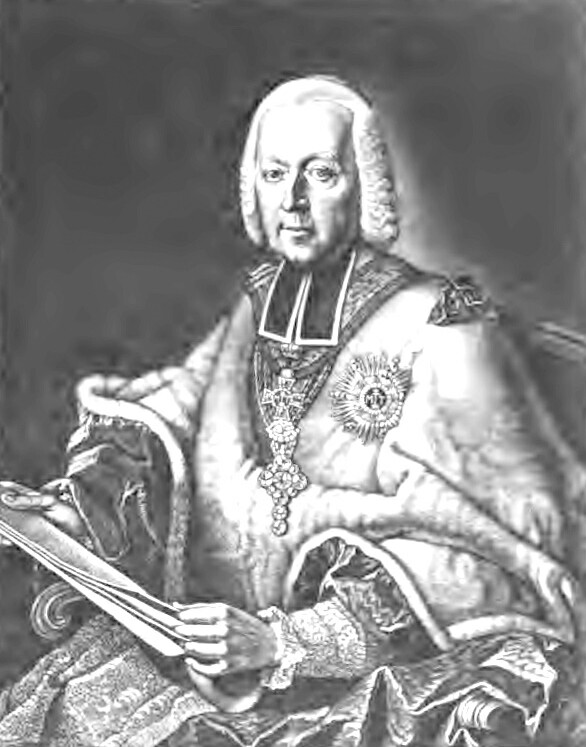
Christoph Cardinal Migazzi
The Deal
By January 19, it had become obvious and inevitable that negotiations would have to take place between the two parties, the Crowns and the Zelanti, to find a cardinal (probably not from the cardinals of the Crowns) on whom both sides could agree. Finally Cardinals Castelli and Giovanni Battista Rezzonico, who had the greatest influence among the Zelanti, called on Cardinal de Solis, the closest person the cardinals of the Crowns had to a disinterested supporter of the Church [Biker (editor), Collecção dos Negocios de Roma... Additamento a Parte III, p. 91: letter of the Conde de Florida Blanca to the Marques de Pombal, January 19, 1775]. The six candidates of the Zelanti who were pulling the largest number of votes were: Colonna, Pamphili, Torrigiani, Negroni, Casale, and De Simone. The Colonnas and Torrigiani, however, were completely out of the question, as far as the Crowns were concerned. On February 2, Florida Blanca informed the Marques de Pombal that none of the six Zelanti would be acceptable.
The Scrutiny on February 9, 1775 brought Cardinal Serbelloni 7 votes, Bufalini 20, Fantuzzi 16, Conti 13, Malvezzi 11, and Marefoschi 3 [Biker (editor), Collecção dos Negocios de Roma... Additamento a Parte III, p. 93].
On February 12, 1775, Bernis had a conversation with Cardinal Braschi, and in it he set forth the requirements of the Spaniards: no restoration of the Society of Jesus, revocation or suspension of the bull In Coena Domini (which excommunicated secular rulers who touched Church property or rights), and no agitation over claims to Parma, Piacenza and the Two Sicilies (which were papal fiefs, but which were occupied by the Spaniards without the proper legalities). On the 13th, Bernis and Braschi met again to determine who would fill the important offices in the papal government. On the 14th, Bernis undertook the job of producing a two-thirds majority for the agreeable Braschi. On the 15th of February, Braschi was elected unanimously. There was, however, a considerable fuss at the Scrutiny. The scene is described by the Spanish Minister, Florida Blanca [tr. William Coxe, Memoirs of the Kings of Spain of the House of Bourbon I (London 1813), pp. 406-407]:
A particular circumstance occurred in the scrutiny of the morning, which shews the influence of the king of Spain in the conclave. Almost all the cardinals being assembled in the Sistine chapel for the election, and informed, by my billets, of the disposition of the crowns towards Braschi, they began to deposit their votes open in the chest. When they had thus declared themselves, cardinal de Solis, who had been retarded by accident, entered, and not having received my billet, he refused to give his consent in the name of your majesty to the continuance of the election. Although the other cardinals of the crowns shewed him my billets, they could not convince him; he even protested against their choice. This protest astounded and embarrassed the whole sacred college; without further dispute, the cardinals withdrew their votes from the chest, and made another scrutiny. At the conclusion of the act, however, as they went out of the chapel, my billet reached Solis. Without a moments delay, all the cardinals unanimously concurred in acknowledging and adoring Braschi that very evening, as the successor of St. Peter, and proclaimed the election on the following day.
Again, as in 1769, the successful candidate, Giovanni Angelo Braschi (Pius VI), was a person who was not clearly identified with either point of view, and who was ill-equipped to deal with the real threats of the Enlightenment, anti-clericalism, atheism, and republican revolutionary trends.
Pope Pius VI was consecrated a bishop on February 22, 1775, by Cardinal Giovanni Francesco Albani, Bishop of Porto, and crowned immediately afterwards, by Cardinal Alessandro Albani, the Cardinal Protodeacon. He took possession of the Lateran Basilica, his cathedral church, on November 30, 1775. [Moroni, 88]. Cardinal Pallavicini was continued in office as Secretary of State; Cardinal Negroni became pro-Datary; Cardinal Conti became Secretary of Briefs; the Secretary of Memorials was Cardinal Giovanni Battista Rezzonico [Cardinal Conti to the Marquis de Pombal, February 23, 1775: Biker (editor), Collecção dos Negocios de Roma... Additamento a Parte III, p. 93].
On April 14, 1782, Pius VI conceded to the Emperor of Austria, Joseph II, the privilege of nominating one in every four bishops to Sees in Austrian held Lombardy, with the exception of the Archbishopric of Milan [A. Galante, Fontes Iuris Canonici selecti (Oeniponti 1906), p. 270 no. 6].
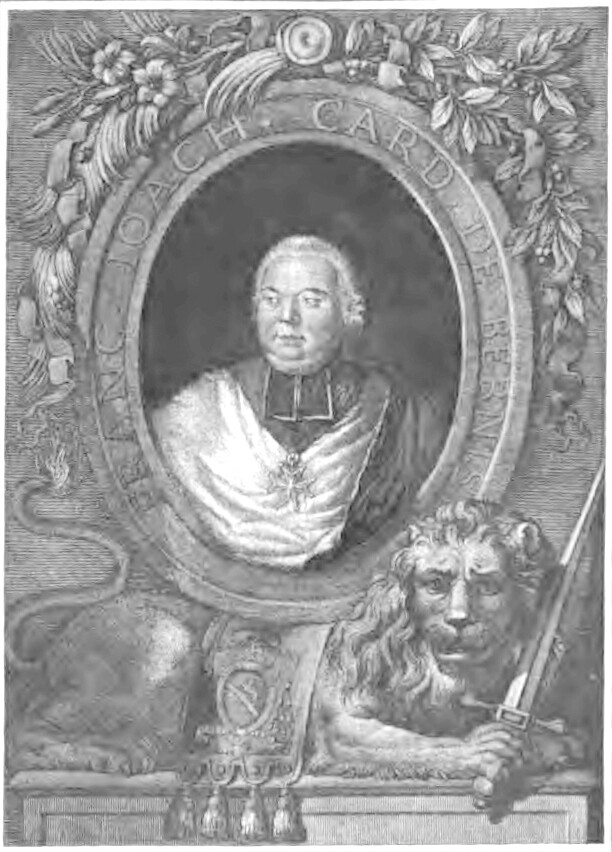
François-Joachim Cardinal de Bernis
Cardinal Bishop of Albano
Bibliography
On the death of Pope Clement: Anatole de Montaiglon and Jules Guiffrey (editors), Correspondence des Directeurs de l' Academie de France à Rome XIII, 1774-1779 (Paris: Jean Schemit 1904), nos. 6534-6535, 6541-6548 [letters of Cardinal de Bernis].
"La società Romana dal 1766 al 1780, Lettere famigliari di Monsignor Giorgio D'Adda, Prefetto della Segnatura [di Giustizia] in Roma," in Felice Calvi, Curiosità storiche e diplomatiche del secolo decimottavo (Milano: Antonio Vallardi 1878), pp. 307-415
Auguste Carayon (editor), Documents inédits concernant la Compagnie de Jésus XVII (Poitiers: Henri Oudin 1869).Augustinus Theiner (editor), Clementis XIV pont. Max. Epistolae et Brevia selectiora (Paris: Didot 1852). Alexis Francois Artaud de Montor, Histoire des souverains pontifes romains Volume VII (Paris 1852) 378-386, refuting the rumors of poisoning and correcting the record as to Cardinal de Bernis' considered judgment. Agostino Theiner, Geschichte der Pontifikats Clemens XIV 3 vols. (Leipzig 1853); Histoire du Pontificat de Clement XIV (Paris: 1852) [translated from the German]; Storia del pontificato di Clemente XIV Volume III (Milano: Carlo Turati 1855) 376-400 (including a denunciation of Crétineau-Joly, Clément XIV et les jésuites). Xavier de Ravignan, Clément XIII et Clément XIV (Paris 1854) 455-457.
Julio Firmino Judice Biker (editor), Collecção dos Negocios de Roma no Reinado de El-Rey Dom José I. Ministerio do Marquéz de Pombal e Pontificado de Clemente XIV, 1769-1774 Parte III (Lisboa, 1874). Manuel Danvila y Collado, Reinado de Carlos III Tomo III and Tomo IV (Madrid: El Progreso Editorial 1894). François Rousseau, Règne de Charles III d'Espagne (1759-1788) Tome Premier (Paris: Plon 1907), especially pp. 377-417.
On the Conclave of 1774, treat with great caution: Jean-François Bourgoing, Mémoires historiques et philosophiques sur Pie VI et son pontificat, jusqu'a sa mort: ou l' on trouve des détails curieux sur sa vie privée, sur ses querelles avec les diverses puissances de l' Europe, sur les causes qui ont amené le renversement du tröne pontifical, et sur la révolution de Rome I (Paris: F. Buisson, 1800) 18 ff. [ill-informed, anti-papalist; among other things, he accepts and uses the forged letters of Caraccioli; see the critical note by Abbé de la Couture in Baldassari, p. 3-4 n.]. Pietro Baldassari, Histoire de l'enlèvement et de la captivité de Pie VI (Paris Adrien le Clerc 1839). Frédéric Masson, Le Cardinal de Bernis, depuis son ministère (1758-1794) (Paris: Plon 1884) 300-318. Alexis François Artaud de Montor, Histoire des souverains pontifes romains Volume VIII (Paris 1852) 18-95 (derived from Novaes, amplified with French documents). Ferdinando Petruccelli della Gattina, Histoire diplomatique des conclaves Volume IV (Paris: 1866). David Silvagni, La corte e la societa romana nei secoli XVIII e XIX Volume primo, seconda edizione (Firenze 1882), 228-249. David Silvagni, Rome, its Princes, Priests and People (tr. F. Maclaughlin) Volume I (London 1885). J. Gendry, "Le Conclave de 1774-1775 et la première année du Pontificat de Pie VI," Revue des questions historiques 51 (1892), 424-485. Cölestin Wolfsgruber, Christoph Anton Kardinal Migazzi Fürsterzbischof von Wien (Sanigau 1890) 224-253. Francesco Antonio Vitale, Memorie istoriche e segrete del conclave del pontifice Pio VI, eletto mercoledi 15 febrajo 1775 (a cura di Ortensio Zecchino) (Rubbettino 2005) 78 pp. Fredrik Nielsen, The History of the Papacy in the XIX Century (tr. A. J. Mason) Volume I (London 1906) 85-87; 165-166 [declines to enter into any of the controversies surrounding the death of Clement XIV or the Conclave of 1774, basing his narrative on Theiner, Reumont and Masson].
For the papal bull In Coena Domini, see: The Papal Bull In Coena Domini, translated into English, with a short historical introduction (London: John Hatchard & Son 1848).
Ludwig Wahrmund, Das Ausschliessungs-recht (jus exclusivae) der katholischen Staaten Österreich, Frankreich und Spanien bei den Papstwahlen (Wien: Holder 1888). Ludwig Wahrmund, "Beiträge zur Geschichte des Exclusionsrechtes bei den Papstwahlen aus römischen Archiven," Sitzungsberichte der Kaiserliche Akademie der Wissenschaften in Wien, philosophisch-historische Klasse, Band CCXXII, xiii (Wien 1890). Ludwig Wahrmund, Zur Geschiste des exclusionrechtes bei den Papstwahlen im 18 Jahrhundert. Neue Beitrage aus römischen Archiven ( Mainz 1892).